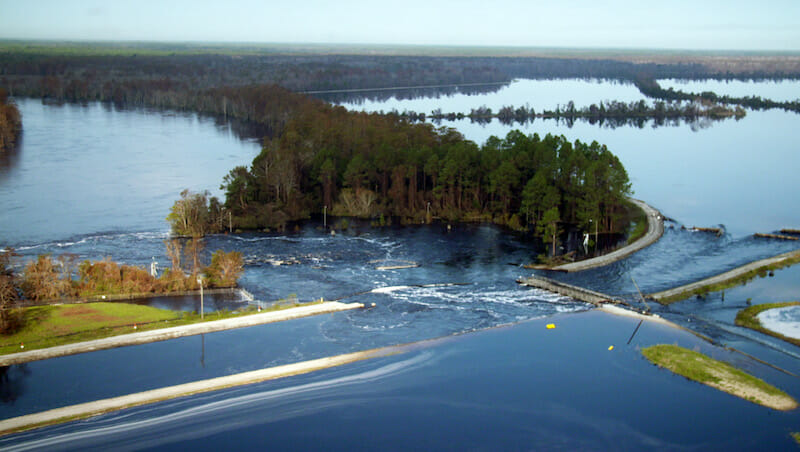Toxic Coal Ash Leaks Into N. Carolina Rivers in Wake of Florence
Exposure to the contaminant, which contains arsenic, mercury and lead, has serious long-term health consequences. Water from a dam breach at the L.V. Sutton Power Station flows into North Carolina's Cape Fear River on Saturday. (Duke Energy)
Water from a dam breach at the L.V. Sutton Power Station flows into North Carolina's Cape Fear River on Saturday. (Duke Energy)
Heavy rains from Hurricane Florence have caused a dam breach at a disused power plant, contaminating the Cape Fear River at Wilmington, N.C., with coal ash.
On Sept. 15, Duke Energy said a leak from a landfill of coal ash at its L.V. Sutton Power Station resulted in the release of 2,000 cubic yards of coal ash, which contains contaminants including arsenic, mercury and lead. On Sept. 16, the Environmental Protection Agency reported a second leak. The Duke Energy H.F. Lee Plant in Goldsboro, N.C., also is leaking coal ash, into the Neuse River.
The repercussions of coal ash releases are well documented. In December 2008, a dike burst at the Tennessee Valley Authority’s Kingston Fossil Plant, releasing 5.4 million cubic yards of coal ash. It damaged 42 properties and cost billions in repairs. Lawsuits contend that more than 200 people who worked on the cleanup effort have contracted lung diseases, cancers and skin conditions, and that at least 30 workers died following the spill. One suit contends that a TVA contractor lied to the workers about the dangers of the coal ash and refused to let them use protective gear.
“When new men would come in on the job, they would be healthy like you. After a couple of weeks on the job, it sucked the life out of them. They would start the cough,” a worker, Jeffrey Dwight Brewer, said.
Duke Energy lobbied the Environmental Protection Agency in 2017 and 2018 on “issues related to Clean Water Act regulations in regards to coal ash,” according to federal lobbying records. The electric power holding company has reportedly spent more than $2 million on lobbying this year, according to Federal Election Commission data reviewed by OpenSecrets.
In July, the EPA extended deadlines on coal ash storage regulations by 18 months, allowing areas at risk of leakage to stay open past the date originally set in 2015—although officials in North Carolina said this delay would not affect the state’s cleanup plan.
“These are ongoing spills that will continue until the floodwaters recede,” said attorney Pete Harrison, who works for the nonprofit public interest group Earthjustice. “It’s mind-boggling that these power companies built their toxic waste dumps right next to flood-prone rivers. It means that every time there’s a major flood, downstream communities have to worry about being exposed to toxic coal ash—as if they don’t already have enough to worry about.”
Seventy percent of coal ash dumps are in low-income communities, according to Earthjustice.
Your support matters…Independent journalism is under threat and overshadowed by heavily funded mainstream media.
You can help level the playing field. Become a member.
Your tax-deductible contribution keeps us digging beneath the headlines to give you thought-provoking, investigative reporting and analysis that unearths what's really happening- without compromise.
Give today to support our courageous, independent journalists.






You need to be a supporter to comment.
There are currently no responses to this article.
Be the first to respond.